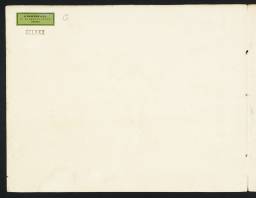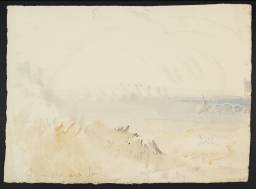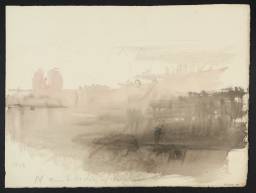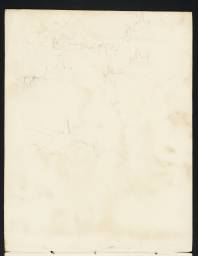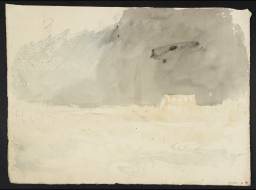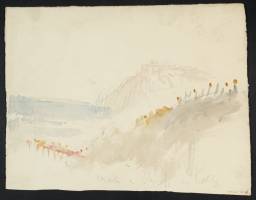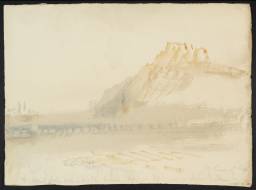From the entry
This section includes thirteen loose colour studies that were, according to the Turner Bequest’s first cataloguer, A.J. Finberg, found together within the covers of a roll sketchbook. It is unlikely, however, that the sheets were ever actually bound within the book’s covers. While the sketches are for the most part believed to be ideas for compositions relating to the life of Napoleon Bonaparte (1769–1821), they remain mysterious, with few of the subjects readily identifiable and many of the inscriptions deemed ‘practically illegible’ by Turner scholars. It is clear, however, that Turner inscribed a number of the sheets with the letter ‘N’, and the subject of the most firmly identified sheet in relation to Napoleon, Adieu Fontainebleau (Tate D27546; Turner Bequest CCLXXX 29), is certainly suggestive that the ‘N’ added to other sheets indicates Napoleon. Napoleon’s impact on Turner’s artistic output was considerable. ...
References
This section includes thirteen loose colour studies that were, according to the Turner Bequest’s first cataloguer, A.J. Finberg, found together within the covers of a roll sketchbook1. It is unlikely, however, that the sheets were ever actually bound within the book’s covers.2 While the sketches are for the most part believed to be ideas for compositions relating to the life of Napoleon Bonaparte (1769–1821), they remain mysterious, with few of the subjects readily identifiable and many of the inscriptions deemed ‘practically illegible’ by Turner scholars.3 It is clear, however, that Turner inscribed a number of the sheets with the letter ‘N’, and the subject of the most firmly identified sheet in relation to Napoleon, Adieu Fontainebleau (Tate D27546; Turner Bequest CCLXXX 29), is certainly suggestive that the ‘N’ added to other sheets indicates Napoleon.
Napoleon’s impact on Turner’s artistic output was considerable. With the exception of his first tour of the Alps during the brief Peace of Amiens in 1802, the Napoleonic Wars confined Turner’s earlier career to British shores, limiting his early subject matter; conversely, his frequent travels following Napoleon’s defeat benefitted from the new roads initiated by the past emperor. Napoleon’s presence is directly felt within some of Turner’s paintings, most notably Snow Storm: Hannibal and his Army Crossing the Alps (Tate N00490; exhibited 1812), which alludes to Napoleon, and the depiction of Napoleon himself seen in War. The Exile and the Rock Limpet (Tate N00529; exhibited 1842).
Napoleon was the subject of paintings by many British artists of Turner’s day, from admiring portraits by Benjamin Robert Haydon (1786–1846) to David Wilkie’s commanding, but less flattering, portrait of the emperor at Fontainebleau. The writers Walter Scott (1771–1832), Robert Southey (1774–1843) and William Wordsworth (1770–1850) each penned celebratory verses following Napoleon’s defeat at Waterloo, while Byron (1788–1824), a Napoleon admirer, instead emphasised the battle’s grim aftermath in his Childe Harold’s Pilgrimage. Turner exhibited lines from Byron’s poemwith his own Field of Waterloo (Tate N00500; exhibited 1818), suggesting sympathy towards Byron’s unhappy assessment of a battle resulting in: ‘Rider and horse – friend, foe, in one red burial blent!’. Byron hardly exaggerated the bloodiness of the battle: 45% of all combatants at Waterloo were killed or wounded.4
Turner dealt most fully with Napoleon’s life in sixteen illustrations for Walter Scott’s Life of Napoleon Buonaparte (1834–6)5; these emphasise relevant Napoleonic ‘localities’ suggested by the editor including Brienne, Paris and Fontainebleau.6 While Finberg dated the present group of studies in line with these illustrations for Scott, the relationship appears fairly distant and only the study related to Fontainebleau (Tate D27547; Turner Bequest CCLXXX 29) seems to share a subject with the earlier grouping. This disconnect, and the indistinct nature and apparent complexity of the present group, has since seen the studies dated later, to c.1841–2. This puts them more in line with Turner’s late assessment of Napoleon on canvas, War. The Exile and the Rock Limpet. It seems likely that Turner had his earlier work for Scott’s Life (and perhaps also the material he gathered for it during his 1832 French tour7) in mind when making the present studies, however, particularly those thought to show Fontainebleau and Waterloo. The most frequent motif found in the present group, though, is unconnected: five of the subjects that have been identified, either previously or tentatively by the present author, appear to show Coblenz and the fortress of Ehrenbreitstein (Tate D27543–D27544, D27549, D27553, D27555; Turner Bequest CCLXXX 26–27, 32, 36, 38). This subgroup may relate to an 1841 group of studies showing Ehrenbreitstein in different light conditions that art historian Ian Warrell noted were made on the same sort of paper (see Tate D35863, D36138, D36166, D36177, D36186, D40181, D36206; Turner Bequest CCCLXIV 26, 285, 309, 319, 328, 328a, 346).8 Of these, Tate D35863 is most similar to the ‘Napoleon’ grouping dealt with here, loosely resembling one of the views of Ehrenbreitstein included in this section (Tate D27544; Turner Bequest CCLXXX 27).
Turner first visited the Rhine in 1817 – using Napoleon’s new road between Cologne and Mainz9 – and returned a number of times. The art historian Cecilia Powell concluded that Turner’s first Rhine tour saw him ‘confronted with different aspects of the seizure and long occupation of the Rhineland by Napoleonic troops... at almost every turn of the river he saw yet another medieval castle, already wrecked during the wars of the seventeenth century, freshly devastated and blackened with smoke.’10 Ehrenbreitstein, situated opposite Coblenz on the confluence of the Rhine and Mosel, was the largest fortress to be destroyed by Napoleon’s troops and subsequently rebuilt: it became a favourite subject for Turner, and one that was still occupying his thoughts in 1841, as demonstrated by the previously noted colour studies. It is possible that associations with Napoleon gleaned during his first visit two years after the emperor’s defeat remained present in his mind: as Powell has stated, his 1817 tour influenced the views of the Rhine he made much later, when illustrating Scott and into the 1840s.11
Turner’s renewed interest in the long-dead Napoleon in the early 1840s was likely triggered by the return from St Helena, and subsequent reburial of, Napoleon’s body in Paris in December 1840, which was widely reported.12 It seems especially notable that War. Exile and the Rock Limpet apparently dates from the same resurgence of creative interest in Napoleon demonstrated by these mysterious, sometimes Rhine-set, sketches, although none appear closely related to the painting. Like this canvas, these unfinished studies appear deeply complex, with subjects as diverse as the death of Napoleon and the death of Dido apparently suggested by broad strokes of watercolour and barely legible inscriptions.
For an introduction to Turner’s illustrations to Scott’s Life of Napoleon, see Gerald Finlay, ‘Scott’s Prose Works’ in Evelyn Joll, Martin Butlin and Luke Herrman ed., The Oxford Companion to J.M.W. Turner, Oxford 2001, pp.284–5.
How to cite
Elizabeth Jacklin, ‘Napoleon Recollections c.1841–2’, September 2018, in David Blayney Brown (ed.), J.M.W. Turner: Sketchbooks, Drawings and Watercolours, Tate Research Publication, November 2019, https://www

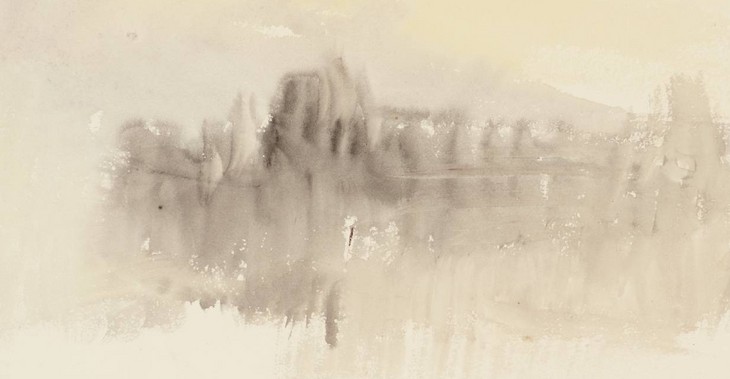

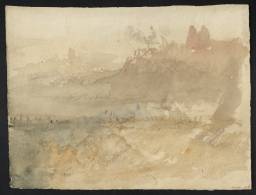
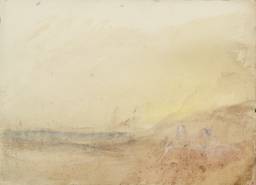
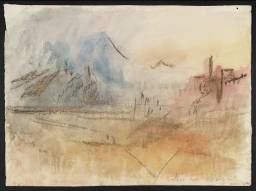
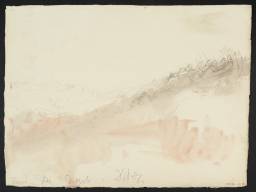
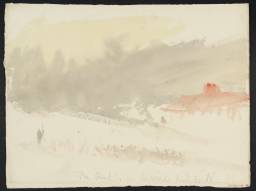

![Ehrenbreitstein: ‘The March of N from Cob[lenz]’](https://media.tate.org.uk/art/images/work/D/D27/D27544_8.jpg)
